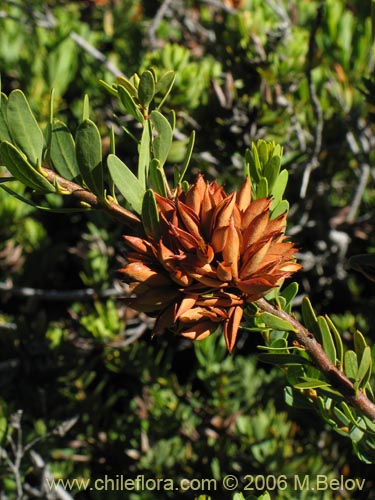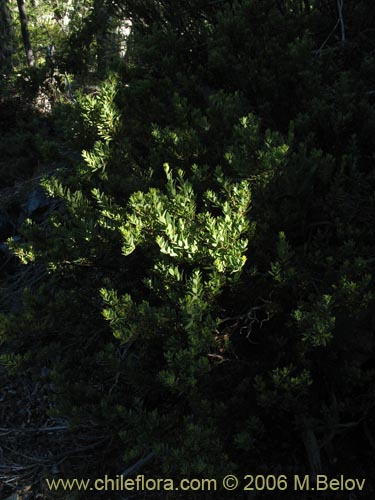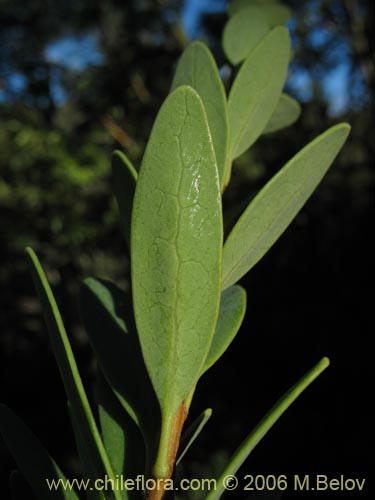|
|

Image of Orites myrtoidea
VIII Region, Los Angeles y Shangri-la, Chile
Altitude: 300-1500 m. 03 19, 2006
|
|
| Species: | Orites myrtoidea (Poepp. & Endl) Benth. & Hook ex B.D.Jacks | |
| Family: | Proteaceae | |
| Order: | Proteales | |
| Chilean Name: | Radal enano | |
| English Name: | ||
| German Name: | ||
| Russian Name: | ||
| Record: | 0066 |
| About 1 Orites in Chile and 1 in our data base. | |
| About 7 Proteaceae in Chile and 7 in our data base. |
  |
|
|
|
|
| Endemic Very Rare
Height: 2 m. Good ornamental value (A) |
INTRODUCTIONThis is an endangered and truly rare Chilean plant which few people have seen. It grows only in a few locations in Chile in very specific environmental conditions; what is more, in most locations there are just a few plants. But it is a truly amazing shrub, since it can grow in lava fields where no other tree or brush can grow. In the sping in flowers with beatiful densely-pacted flowers, and in autumn the fruits glow with reddish-brown color, contrasting with the green foliage and the blacklava. If you are looking for an exotic shrub which would reflect the spirit of the Chilean volcanic Andes, this is the plant to go for. |
|
Image of Orites myrtoidea VIII Region, Los Angeles y Shangri-la, Chile
|
DESCRIPTIONPlant type: Shrub Flower: White, without information on the number of petals Height: 2 m.
This is an evergreen shrub which grows up to 2 m, but mostly is rather low (0,5 - 1 m) and wide, forming sometimes large groups which extend for 5 to 10 m. The leaves are coriaceous, about 3 cm long and 1 cm wide, with short petioles, oblong. The flowers come in compact racemes, of whitish or yellowish color, flowering in October and November. The seeds are winged, about 1,5 cm long and appear in February and March. |
|
Image of Orites myrtoidea VIII Region, Los Angeles y Shangri-la, Chile
|
HABITATIn Chile this species grows in the following environmental conditions:
Habitat according to altitude: Medium altitude up to the timber line
Watering conditions: Somewhat dry areas where the drought may last 3 - 5 months. Precipitations of 400 - 800 mm. are concentrated in winter.
Light conditions: Fully exposed to the sun. Level areas or slopes facing north.
This plant is difficult to grow because of its rather strict habitat requirements: volcanic soil, middle altitudes, lot of sun, enough water. It grows in Central-southern parts of Chile, in 7-9 regions. |
|
Image of Orites myrtoidea VIII Region, Los Angeles y Shangri-la, Chile
|
USESGood ornamental value (A)
- |
|
Image of Orites myrtoidea VIII Region, Los Angeles y Shangri-la, Chile
|
GROWING TIPSThis species has the following hardiness: USDA Hardiness Zone 8. The plant tolerates low temperatures (-8° C), can tolerate occasional snow cover for up to a couple of weeks per year.
Very difficult to cultivate
Average germination, 30 - 60 %
Prior to planting, the seeds should be soaked in gilberic acid for a day or so. The soil must have good drainage? and preferibly be volcanic sand, with some organic matter added. If no volcanic sand can be found, some acid soil may work as well (lava is acid?). The seeds generally germinate well, and initial growth is good, but be warned, that unless the environmental conditions (soil, watering, sunlight, and temperature) are right, the plant often dies later. It is ideally suited to be grownin mountain areas with some snow cover. Another germination strategy may be the normal stratification procedure (moist sand at 5ºC for a couple of weeks and than warmer temperature). If you are interested in purchasing seeds of this or similar species, please go to our On-line Seeds Shop. |
|
More photos (17) of Orites myrtoidea (Poepp. & Endl) Benth. & Hook ex B.D.Jacks available here |
|
More species from the same Proteaceae family in our data base: Embothrium coccineum fma. andina (Notro andino / Ciruelillo) Embothrium coccineum (Notro, ciruelillo) Gevuina avellana (Avellano / Gevuín) Lomatia dentada (Avellanillo / Avellanito / Palo negro / Piñol) Lomatia ferruginea (Fuinque / Palmilla) Lomatia hirsuta (Radal / Raral / Nogal silvestre) Orites myrtoidea (Radal enano) |




